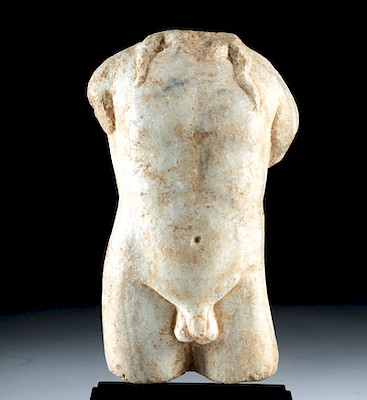Impressive Roman Bronze Oil Lamp w/ Mask Handle
Lot 29
About Seller
Artemis Gallery
686 S Taylor Ave, Ste 106
Louisville, CO 80027
United States
Selling antiquities, ancient and ethnographic art online since 1993, Artemis Gallery specializes in Classical Antiquities (Egyptian, Greek, Roman, Near Eastern), Asian, Pre-Columbian, African / Tribal / Oceanographic art. Our extensive inventory includes pottery, stone, metal, wood, glass and textil...Read more
Estimate:
$5,000 - $7,000
Absentee vs Live bid
Two ways to bid:
- Leave a max absentee bid and the platform will bid on your behalf up to your maximum bid during the live auction.
- Bid live during the auction and your bids will be submitted real-time to the auctioneer.
Bid Increments
| Price | Bid Increment |
|---|---|
| $0 | $25 |
| $300 | $50 |
| $1,000 | $100 |
| $2,000 | $250 |
| $5,000 | $500 |
| $10,000 | $1,000 |
| $20,000 | $2,500 |
| $50,000 | $5,000 |
| $100,000 | $10,000 |
| $200,000 | $20,000 |
About Auction
By Artemis Gallery
Dec 5, 2018
Set Reminder
2018-12-05 10:00:00
2018-12-05 10:00:00
America/New_York
Bidsquare
Bidsquare : DAY 1 | Classical Antiquities & Asian Art
https://www.bidsquare.com/auctions/artemis-gallery/day-1-classical-antiquities-asian-art-3698
Day 1 of an important 2-day auction featuring ancient and ethnographic art from around the world. Egyptian, Greek, Roman, Viking, Near Eastern plus Asian Art from China, Japan, Thailand, Vietnam, Burma, India, more. Artemis Gallery info@artemisgallery.com
Day 1 of an important 2-day auction featuring ancient and ethnographic art from around the world. Egyptian, Greek, Roman, Viking, Near Eastern plus Asian Art from China, Japan, Thailand, Vietnam, Burma, India, more. Artemis Gallery info@artemisgallery.com
- Lot Description
Roman, Imperial Period, ca. 1st to 2nd century CE. A cast bronze oil lamp with a pear-shaped body leading to a curvaceous spout as well as an impressive maskette for the handle terminal with expressive facial features including an open mouth, a coiffure featuring a wavy fringe of bangs with long ringlets falling to either side of the chin, and a pronounced helmet or diadem atop. The fill hole presents an intriguing form with a clover-shaped head over a pointed extension. The sill is artistically rendered as is the seamless bevel surrounding the recessed top of the vessel. All sits upon a sturdy flared, circular, concave base marked by two concentric circles. Enveloped in a sage-hued patina, this is a truly exceptional example from the Roman Empire! Size: 8.25" L x 6.375" H (21 cm x 16.2 cm)
Oil lamps such as this were filled with olive oil, had a wick placed inside the spout, and were used to light homes, shops, holy places, and many other locations throughout the Roman world. Oil lamps were certainly among the most ubiquitous objects in antiquity; however, finely crafted examples like this one were more unusual.
As in Greece, masks played an important role in Roman theatre. An actor's entire head and hair would be covered by a large mask of simple design, made from linen or cork, with holes for the mouth and eyes. These masks allowed audience members seated in all areas of the theatre to understand what was happening, while also amplifying the actor's voice. The Pompeiian mosaic from the House of the Tragic Poet (now in the Naples National Archaeological Museum) shows several examples of these masks including one actor wearing an example pushed up on his head. Mask motifs on decorative art as well as utilitarian objects speak to the power and popularity of Roman theatre.
Despite the prevalence of terracotta lamps, bronze oil lamps are among some of the rarest artifacts to come from the Roman Empire. Their scarcity, however, is a reminder of how everyday life would have been for the people who used them. Bronze examples like this were only affordable to upper class households due to the inherent cost and time associated with the processing, refinement, and ultimately casting of bronze. This particular example is much finer than the average, with its meticulous attention to detail and sturdy composition, and was probably created for and belonged to a member of the Roman elite who would have passed it down as a family heirloom.
Provenance: private East Coast, USA collection
All items legal to buy/sell under U.S. Statute covering cultural patrimony Code 2600, CHAPTER 14, and are guaranteed to be as described or your money back.
A Certificate of Authenticity will accompany all winning bids.
We ship worldwide and handle all shipping in-house for your convenience.
#138955Small loss to right eye - perhaps a casting flaw. Expected surface wear and abrasions to peripheries commensurate with age. Wonderful blue-green patina.Condition
- Shipping Info
-
All shipping is handled in-house for your convenience. Your invoice from Artemis Gallery will include shipping calculation instructions. If in doubt, please inquire BEFORE bidding for estimated shipping costs for individual items.
-
- Buyer's Premium



 EUR
EUR CAD
CAD AUD
AUD GBP
GBP MXN
MXN HKD
HKD CNY
CNY MYR
MYR SEK
SEK SGD
SGD CHF
CHF THB
THB
















